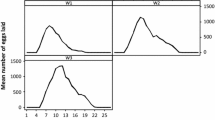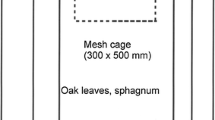Abstract
The survival rate of Amblyomma variegatum engorged nymphs was studied in 9 cohorts released during the first part of the dry season (i.e. the nymph infestation period in the region) and placed on a natural savannah, either in plastic containers or in cages driven into the soil and open at the bottom. All nymphs put in the containers placed in the sun died rapidly, while a high moulting rate (94%) was observed in containers placed in the shade. This rate reached 63% for the ticks released in the cages. The moulting period lasted from less than 4 to more than 6 weeks, depending on the release period: unfed adults are therefore present in the pasture 4–5 months before the onset of the adult infestation period. The survival rate of the unfed adults did not vary according to the release period of the nymphs: at the beginning of the rainy season, 20–25% of the adult ticks were still alive in the cages. Very important variations in survival and disappearance rates were observed according to the place where the cages had been installed: within a few metres, the survival rate could vary from 0 to 90%, presumably because of the activity of predators which removed also dead tick from the plastic containers. Predators may then have a great but highly variable and unpredictable impact on the natural population of A. variegatum adults. Engorged nymphs released on pasture were able to find suitable micro-habitats allowing survival, covered up to 2.8 metres to reach them, and grouped together at the neck or root network of bushes and grass clumps, sometimes burrowing to a depth of 10 cm.








Similar content being viewed by others
References
Barré N (1989) Biologie et écologie de la tique Amblyomma variegatum (Acarina: Ixodina) en Guadeloupe (Antilles Françaises). Dissertation, Université de Paris-Sud-Orsay
Barré N, Mauléon H, Garris GI, Kermarrec A (1991) Predators of the tick Amblyomma variegatum (Acari: Ixodidae) in Guadeloupe, French West Indies. Exp Appl Acarol 12:163–170
Branagan D (1973) Observations on the development and survival of the ixodid tick Rhipicephalus appendiculatus Neumann, 1901 under quasi-natural conditions in Kenya. Trop Anim Health Prod 5:153–165
Butler JF, Camino ML, Perez TO (1979) Boophilus microplus and the fire ant Solenopsis geminata. Recent Advanc Acarol 1:469–472
Diallo M, de La Rocque S, César J (1998) Evolution des formations ligneuses riveraines dans la zone agro-pastorale de Sidéradougou (Burkina Faso) et recherches des causes anthropiques. CIRDES, Bobo-Dioulasso, Burkina Faso
Lloyd CM, Walker AR (1993) The systemic effect of adult and immature Amblyomma variegatum ticks on the pathogenesis of dermatophilosis. Rev Elev Méd vét Pays trop 46:313–316
Minshull JI, Norval RAI (1982) Factors influencing the spatial distribution of Rhipicephalus appendiculatus in Kyle Recreational Park, Zimbabwe. South African J Wildl Res 12:118–123
Norval RAI (1986) Amblyomma variegatum and acute bovine dermatophilosis. Parasitol Today 2:23
Norval RAI, Sutherst RW, Kurki J, Gibson JD, Kerr JD (1988) The effect of the brown ear-tick Rhipicephalus appendiculatus on the growth of Sanga and European breed cattle. Vet Parasitol 30:149–164
Norval RAI, Sutherst RW, Jorgensen OG, Gibson JD, Kerr JD (1989) The effect of the bont tick (Amblyomma hebraeum) on the weight gain of Africander steers. Vet Parasitol 33:329–341
Pegram RG, Banda DS (1990) Ecology and phenology of cattle ticks in Zambia: development and survival of free-living stages. Exp Appl Acarol 8:291–301
Petney TN, Horak IG, Rechav Y (1987) The ecology of the African vectors of heartwater, with particular reference to Amblyomma hebraeum and A. variegatum. Onderstepoort J Vet Res 54:381–395
Randolph SE (2004) Tick ecology: processes and patterns behind the epidemiological risk posed by ixodid ticks as vectors. Parasitol 129:S37–S65
Rechav Y (1979) Migration and dispersal patterns of three African ticks (Acari: Ixodidae) under field conditions. J Med Entomol 16:150–163
Stachurski F, Adakal H (2010) Exploiting the heterogeneous drop off rhythm of Amblyomma variegatum nymph to reduce pasture infestation by adult ticks. Parasitology 137:1129–1137
Stachurski F, Musonge EN, Achu-Kwi MD, Saliki JT (1993) Impact of natural infestation of Amblyomma variegatum on the liveweight gain of male Gudali cattle in Adamawa (Cameroon). Vet Parasitol 49:299–311
Wilkinson PR (1970) Factors affecting the distribution and abundance of the cattle tick in Australia: observations and hypotheses. Acarologia XII:492–508
Yonow T, Gigon F (1993) Model for survival of unfed female Amblyomma variegatum (Acari: Ixodidae) in Kenya. Exp Appl Acarol 17:473–485
Acknowledgments
This study was funded by CIRAD.
Author information
Authors and Affiliations
Corresponding author
Rights and permissions
About this article
Cite this article
Stachurski, F., Zoungrana, S. & Konkobo, M. Moulting and survival of Amblyomma variegatum (Acari: Ixodidae) nymphs in quasi-natural conditions in Burkina Faso; tick predators as an important limiting factor. Exp Appl Acarol 52, 363–376 (2010). https://doi.org/10.1007/s10493-010-9370-z
Received:
Accepted:
Published:
Issue Date:
DOI: https://doi.org/10.1007/s10493-010-9370-z




